Some might be surprised to find that I take every opportunity to photograph bicycle racing. Although I’m primarily an urban and natural landscape shooter (to generalize just a bit) I also have a passion for shooting a few other surprising subjects. One of these is professional bicycle racing. Although I never raced, I was at one time a very serious cyclist. I trained with folks who did race and for several years I rode as if I were preparing to race, doing over 10,000 miles per year. With that in mind, it might seem less surprising that I interrupted my photographs of Death Valley, the coast redwoods, and the Pacific coastline to post a week of bicycle racing photos.
During the last few years I’ve been fortunate to be able to shoot stages of the Amgen Tour of California professional stage race in northern California. As I’ve done so, I’ve gradually figured out more strategies that let me get some effective photographs. Here’s a quick summary of a few of them.
- Time trials, especially those on short courses, can be the best opportunity to shoot riders on their bikes. Each competitor rides the course individually, so you can get a clear view of the rider approaching. Because lower ranked riders go first, you can experiment with locations, lighting, and so forth on them… and have your shooting strategy worked out by the time the big names arrive.
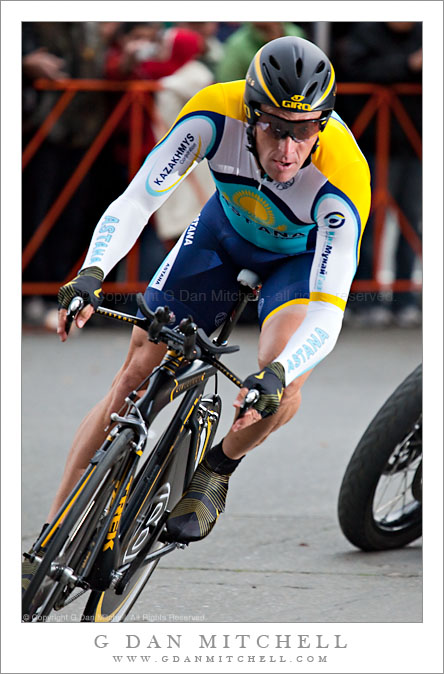
- If you want to shoot the peloton (the pack of riders) try to do so at a start in a downtown area that includes “parade laps” – where the pack does a few loops at less competitive speeds before heading out on the open road. You’ll have similar opportunities at the end of a stage that finishes with several downtown loops, though things tend to happen a lot faster at the end than during the parade laps.

- If you try to shoot a sprint finish and cannot be right at the finish line – and you probably cannot – try to be in the area 100-200 meters from the line. At this point there is tremendous action as the final sprint starts to take place and, in my experience, some very dramatic shots are possible – even more so than at the finish line when the race has usually already been decided.
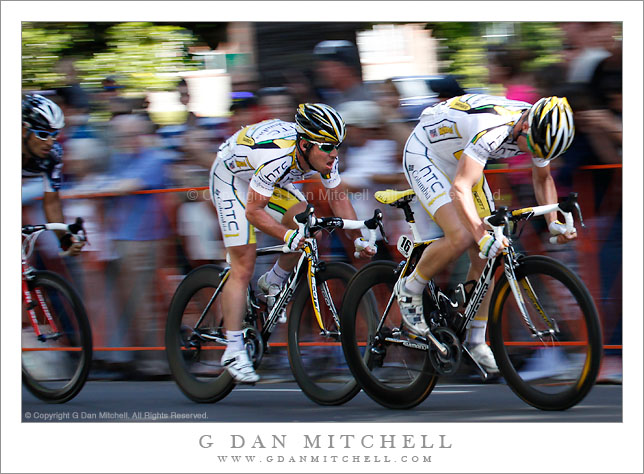
- In all of these situations, unless you are very experienced at tracking riders close up with a long lens as they fly by at high speed… practice on every rider that comes by. I’ll even practice tracking support motorcycles, police escorts – anything that moves. Eventually you want to pan smoothly while you remain continuously aware of the position of the riders in the frame – and the non-rider elements in the background. To put it mildly, this isn’t easy – and it takes a lot of practice.

- When you track riders moving at high speed, think about putting their torsos/hips in the center of the frame vertically. Unless you are shooting very tight, if you center their heads you’ll get lots of empty space above them and cut off their legs and bikes.
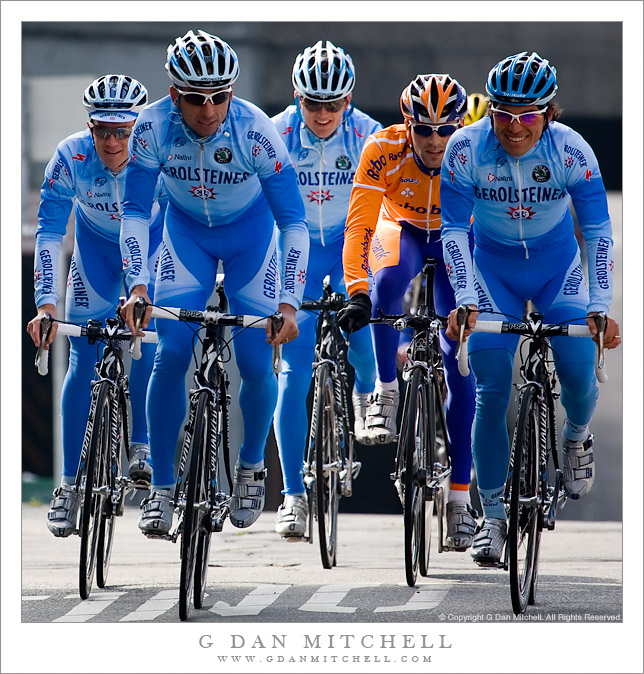
Team Gerolsteiner Warms Up for the Prologue - Pick your shooting location carefully. You certainly want a spot where the riders are likely to be in dramatic and dynamic positions. Turns can be good for this, for example. But also carefully consider the background to your shot – who is standing on the other side of the road and what is beyond the riders. (I once shot a series of riders warming up for a time trial… only to realize later that there was a bright green outhouse behind them!) Also think carefully about the ambient lighting. If the riders are backlit there is a good chance that they will be very dark. I try to place myself in a position where they will be front or side-lit.

- Counter-intuitively, very high shutter speeds may not always be a good choice. Yes, you may stop the action – but you also may end up with very static looking shots. In many cases you’ll more effectively capture the speed and motion of racing if you lengthen the exposure and track the riders, thus allowing some motion blur.
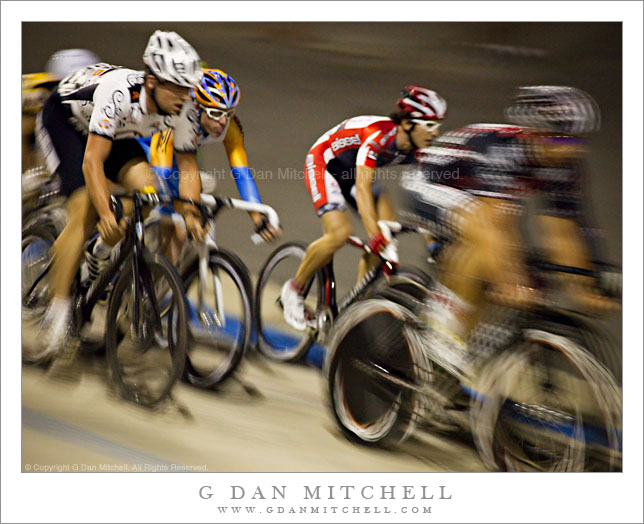
- Don’t let bad weather dissuade you from shooting. Often rain or clouds or fog can make for some of the most dramatic images. Be careful with your gear, but try to take advantage of these conditions.
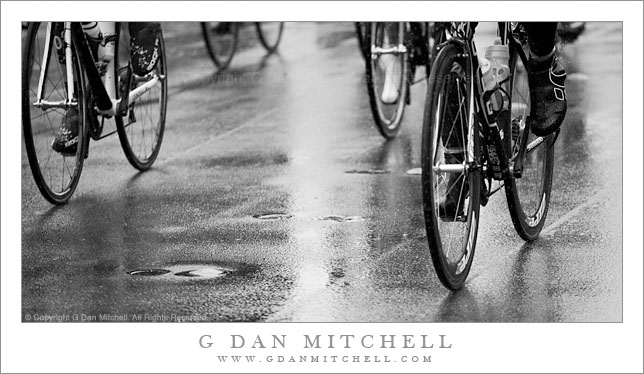
- If you are going to try to shoot the pack in the middle of a long road stage, you need to plan carefully. The road will often close well before the peloton arrives, so you need to be in place well ahead of time – an hour or many hours before the race passes. If possible, scout the area where you think you’ll shoot ahead of time. Look for a dramatic setting – an expansive view, a bridge, forest, anything that can make your shot something other than just “bikes on a road.” Consider shooting on an uphill section – the pack will go more slowly. Try out different focal lengths to see what will work best in your location. Consider having two camera bodies with different lenses – a telephoto to do long shots as the group approaches and a shorter lens to shoot the pack as it is right in front of you.
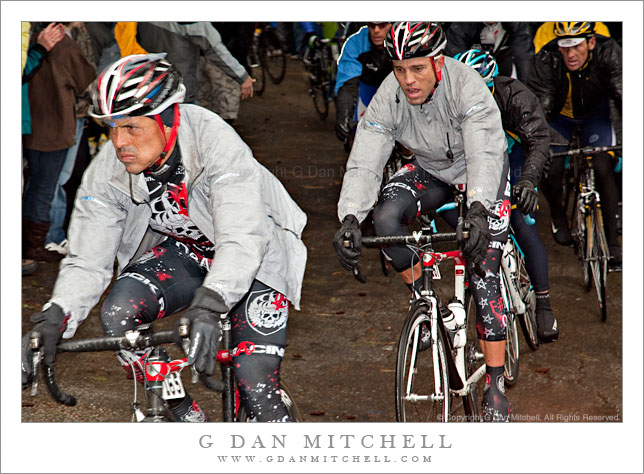
- The pack will pass very quickly. A few motorcycles will pass, then the pack will suddenly appear in a rush of color and wind, followed quickly by the support vehicles… and then they are gone. You’ll have only seconds to shoot. You must pick your spot ahead of time. You’ll almost certainly want to use burst mode – perhaps shooting jpg so that you can get more images before the camera buffer fills. Better to err on the side of using a focal length that is too short (wide) than one that is too long (telephoto) – you can crop later if necessary.
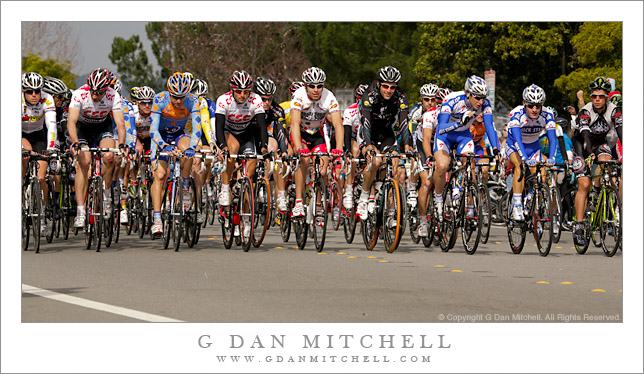
- The actual race is not the only thing worth shooting – there are many, many interesting subjects before and after the race. I often find interesting subjects among the spectators waiting for the pack or even watching the peloton pass. One of the great things about pro bike racing is that you have amazing access to the riders in the team area before the race. I often spend at least an hour there before the race, shooting like crazy so that I don’t miss anyone. You may look up and see Lance Armstrong riding past you five feet away, or you might see some guy you don’t recognize talking to fans – only to find out later in the day that he was the stage winner. I generally use a relatively long lens in this area and “snipe” – getting close shots of riders. (You’ll generally have far fewer opportunities like this after the race, when the riders quickly disappear.)
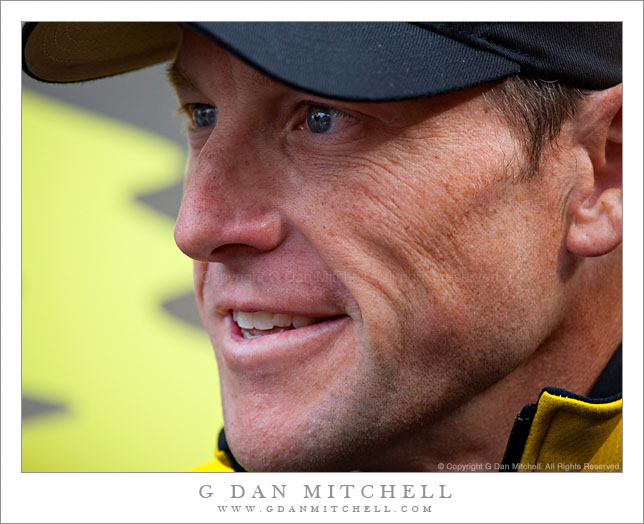
- Occasionally try things that aren’t quite so obvious. I once found myself on an inside corner a few blocks from the end of a stage as the peloton came into town. I put on my widest lens – a 17mm zoom – and stuck the camera through the fence down low to the ground. With the camera in burst mode I shot as riders leaned into the turn only a foot or two from the camera.
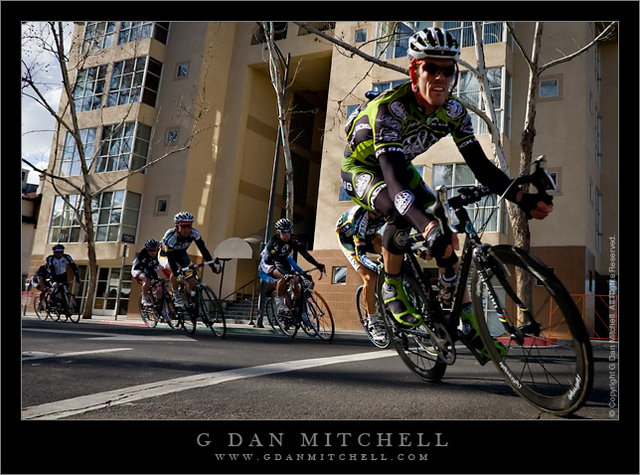
- Large apertures are often better than small apertures. Yes, the small apertures give you greater depth of field – but they also force you to shoot a slower shutter speeds (not always a bad idea…) and put non-central subjects in sharper focus. Often the riders will stand out more against an out of focus background than against a busy in-focus background. (It is difficult to generalize too much about this though – if you are already throwing much of the scene out of focus by using a slow shutter speed, there can be advantages to the smaller aperture.)
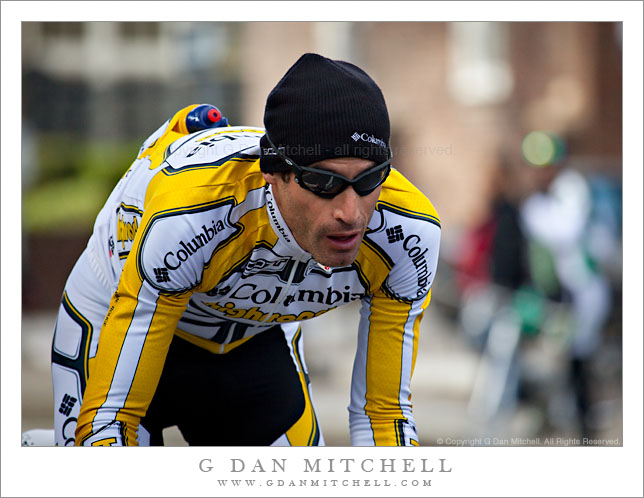
- When shooting individual racers, especially in the team area, do shoot a lot of frames – but also think carefully about what the riders are doing and what they look like. I’ll often try to quickly get an initial shot that is serviceable – but once I get that I become a bit more selective. I’ll watch the subjects face for the most interesting expression or better light. I’ll also watch to see them interact with fans – this often creates really compelling moments.
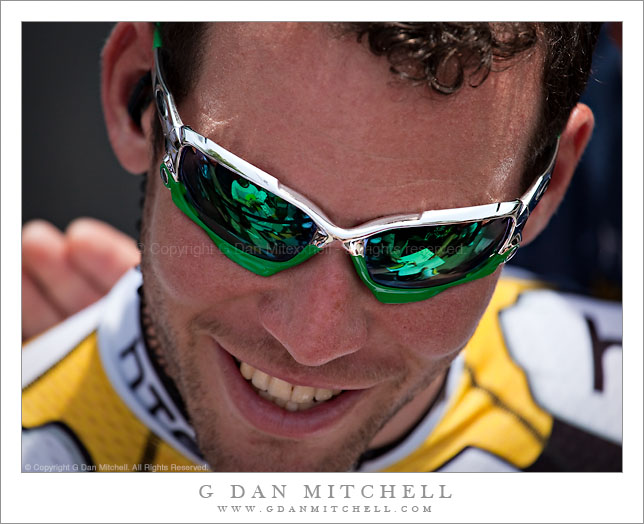
- Shoot a lot. Things happen quickly, and not just on the course. Not every shot is going to be a great one, but you’ll often have little time to carefully consider each shot – better to work on instinct. (Oddly, I realized a few years ago that the closest experience to this might be shooting certain types of wildlife – birds in flight for example.)
© Copyright 2010 G Dan Mitchell – all rights reserved.
 G Dan Mitchell is a California photographer whose subjects include the Pacific coast, redwood forests, central California oak/grasslands, the Sierra Nevada, California deserts, urban landscapes, night photography, and more.
G Dan Mitchell is a California photographer whose subjects include the Pacific coast, redwood forests, central California oak/grasslands, the Sierra Nevada, California deserts, urban landscapes, night photography, and more.
Blog | About | Flickr | Twitter | Facebook | Google+ | 500px.com | LinkedIn | Email
Text, photographs, and other media are © Copyright G Dan Mitchell (or others when indicated) and are not in the public domain and may not be used on websites, blogs, or in other media without advance permission from G Dan Mitchell.
Discover more from G Dan Mitchell Photography
Subscribe to get the latest posts sent to your email.

Great images and suggestions Dan. Like you, I am a cyclist as well and although this is not my main subject matter either I find it really addicting to shoot.
Thanks, Greg and Tom.
Tom, you never know whether moving or staying in one spot will be better. I, too, have moved from a good spot to… a spot that wasn’t anything special. These days I tend to pick two or three and just try to work them. However, if it isn’t happening at one of the them, I’ll move on.
Greg, you are describing what I recall as more or less the classic mountain bike racer shot – the person struggling up some terribly steep section under a great deal of strain. I haven’t shot mountain bike racing myself – though it sounds like fun – but I know that some photogs would also position themselves near a spectacular jump; and other – those with a more gruesome point of view, I suppose – would position themselves near the location of a likely crash!
Dan
Dan:
In regard to Item #9, I agree with you on shooting the bicyclists on a uphill portion. When mountain biking was popular (remember those ancient days?) and Tom Ritchey and his team that he sponsored were kings of the dirt singletrack, I often used this technique to get images not only of Team Ritchey, but the other racers, as well. I often ran to the most difficult uphill portion of the race course and stationed myself there for almost the entire race, thereby getting a better chance at making good, and interesting images.
Not only was the action slower so it was easier to photograph the riders, but the images were made more dramatic by the grimacing of the strained faces, and the beads of sweat pouring off the bicyclists. That was great fun doing that…whatever happened to those days?!
I have no problem with you posting bicycle racing images in between your landscape photos; I enjoy your race images and I wish there were more of them!
The Sea Otter Classic taught me the appeal of circuit races. You get too see and shoot the riders multiple times without a lot of moving.
Of course on Stage One, I tried to do too much on the three circuits around the Capitol. While I got to three shooting locations, the second two locations were less than optimal. I should have just stayed at my first scouted location.